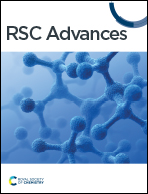Enhancing Tsuji–Trost deallylation in living cells with an internal-nucleophile coumarin-based probe†
Abstract
In recent years, bioorthogonal uncaging reactions have been developed to proceed efficiently under physiological conditions. However, limited progress has been made in the development of protecting groups combining stability under physiological settings with the ability to be quickly removed via bioorthogonal catalysis. Herein, we present a new water-soluble coumarin-derived probe bearing an internal nucleophilic group capable of promoting Tsuji–Trost deallylation under palladium catalysis. This probe can be cleaved by a bioorthogonal palladium complex at a faster rate than the traditional probe, namely N-Alloc-7-amino-4-methylcoumarin. As the deallylation process proved to be efficient in mammalian cells, we envision that this probe may find applications in chemical biology, bioengineering, and medicine.



 Please wait while we load your content...
Please wait while we load your content...